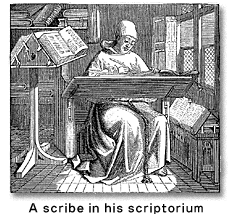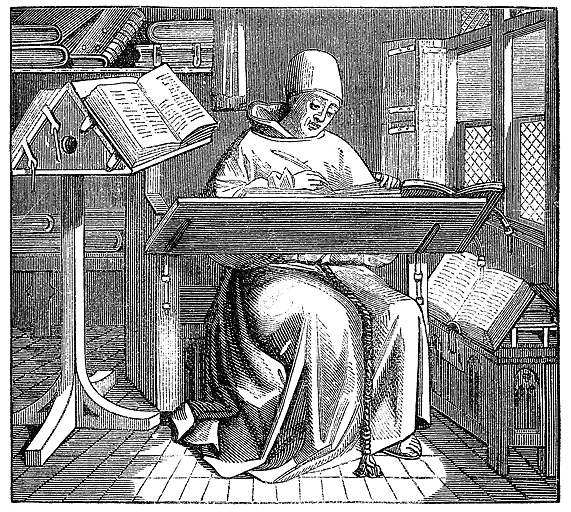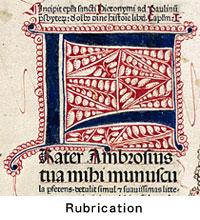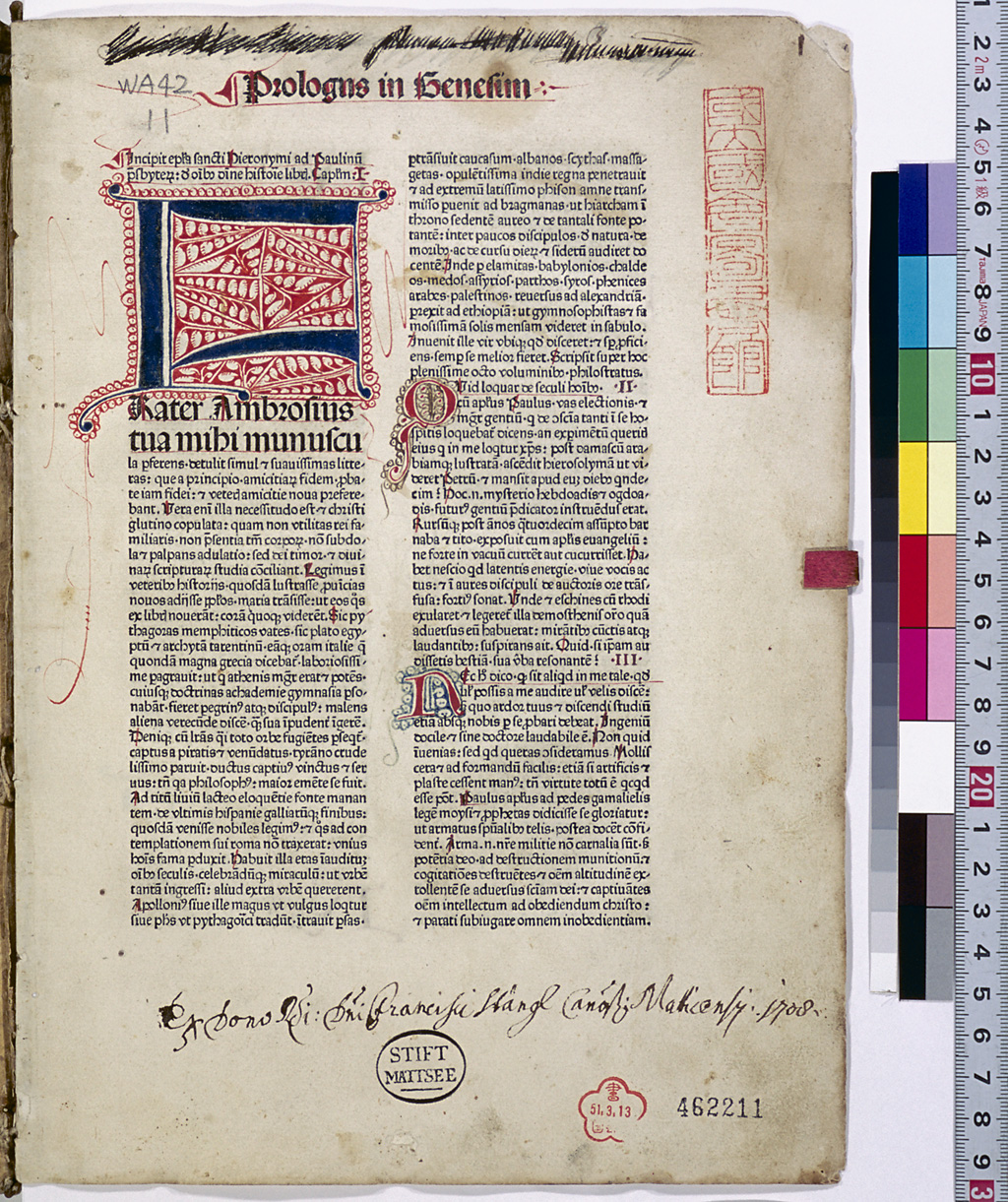Chapter 1
What are Incunabula?
Incunabula is the plural of the Latin word incunabulum, a cradle. Evolving from its original meaning, incunabulum came to mean "place of birth" or "beginning." In the world of books, the word incunabula refers to books that were printed using metal type up to the year 1500. The year 1500 is more a cutoff date of convenience, marking the transition from one century to the next, rather than signifying a definitive change in the appearance of books from 1501 onwards. It was actually around 1530 that a transformation in the appearance of books is said to have begun to take place. The person to whom the invention of printing technology using metal type is attributed is Johann Gutenberg (c.1400 - 1468). The bicentennial anniversary of the invention of printing technology was celebrated in 1640 and it was at this time that the word incunabula first came into use.
The first actual book that Gutenberg printed was the Bible. Books in Europe in the Middle Ages were copied by hand ("manuscripts"), and the vast majority of these were Christian religious works. The word for Bible in Latin is biblia, originally a Greek word meaning "books." Manuscripts were created for religious purposes and they were meant not only to be read but also had beautiful decorative features . The "42-line Bible" that Gutenberg printed is not in fact a wholly-printed work. It was so designed that decorative lettering known as illumination could be applied by hand after completion of the printing process. Even though early printed books were produced in exactly the same style as manuscripts, the process enabled the work to be done more than eight times faster. At the same time, it also resulted in a dramatic reduction in the price of books.
Once the printing of books became established, their production increased. The number of publications (titles) in Europe for the one year period in 1480 exceeded 1,000. At the beginning of the 17th century, the number had risen to 3,000, and at the beginning of the 19th century, it had reached over 5,000. The increase in the production of books was the result of a number of changes and innovations in the design of books including a reduction in size, standardization of type faces, the addition of title pages and pagination. The book industry also underwent such organizational changes as a division of labor with specialist printing type manufacturers, printers, publishers, and book merchants. Nevertheless, until printing presses with steam engines were introduced in the first half of the 19th century, printing was basically a manual process, precluding the kind of mass production of books that is possible today.
Let us now take a look at the characteristics of the incunabula that underwent the transition in design from manuscripts to printed books. Incunabula were first printed in exactly the same style as manuscripts. Therefore, all of the characteristics that appeared in manuscripts were maintained in incunabula. These included the use of diverse typefaces according to genre and region, the use of contractions and abbreviations in sentences, frequent use of columns and marginal notes, and rubrication at the beginning of the chapter. The title page that is standard in all books today began to appear only in the 1480s. Until that time, the text in books began immediately after the title, which was referred to as the incipit. Descriptions of the printer, the year of printing and the place of printing were found in the colophon, a section at the end of the book, or were not shown at all. A look at examples of incunabula shows that there are very few where the place of printing, the name of printer, and the year of printing are all indicated in the book.
Without the indication in a book of its year of publication, it was difficult to judge whether a work was an incunabulum or not. Indeed, a very important theme in the history of incunabula studies has been their identification; that is, determining when, by whom and where they were printed. In fact, Gutenberg's name does not appear in any of the books said to have been printed by him. UP to now, about 1,100 printers of incunabula have been identified, but among these, the names of printers of about 150 cannot be determined or inferred. In such cases, the printer is simply referred to as "the printer of" followed by the name of the work. In this way, printers have been identified and a complete picture of incunabula has been clarified by confirming or inferring when and where the works were printed.
An attempt on a world scale to determine what kind of incunabula were printed and where they are presently housed began in Germany in 1904. It was not until 1925, however, with the publication of the first volume of Gesamtkatalog der Wiegendrucke (GW), that a detailed catalog of incunabula was published. This catalog is a massive work of 27 volumes, with the names of the authors appearing in alphabetical order. So far, however, only 11 volumes have been published. Research has been completed and the GW database, including the record cards, has been placed in the public domain on the Internet by the Berlin State Library-Prussian Cultural Foundation (Staatsbibliothek zu Berlin-Preussischer Kulturbesitz). The GW is an excellent catalog containing all the data that identify incunabula but, because it is taking such an enormous amount of time to publish, the British Library commenced a compilation of a online union catalog, Incunabula Short Title Catalogue (ISTC) in 1980, modeled on the simple catalog entries of the Incunabula in American Libraries (abbreviation: Goff). In 1997, the British Library published a CD-ROM (IISTC) listing about 26,000 incunabula. The ISTC database contains information on the ownership of incunabula around the world. The table below is based on the second edition of the IISTC published in 1998, which shows what kind of incunabula were printed and where they are currently housed.
| Year of Publication | Italy | Germany | France | Netherlands | Spain, Portugal | England | Others |
|---|---|---|---|---|---|---|---|
| 1451-1460 | 0 | 24 | 0 | 0 | 0 | 0 | 0 |
| 1461-1470 | 137 | 232 | 1 | 1 | 0 | 0 | 0 |
| 1471-1480 | 2,595 | 1,788 | 441 | 376 | 83 | 44 | 33 |
| 1481-1490 | 3,045 | 2,953 | 1,320 | 944 | 267 | 109 | 39 |
| 1491-1500 | 4,144 | 3,655 | 2,846 | 866 | 646 | 245 | 62 |
The table above is a cross-tabulation of incunabula according to the year of publication and where they were printed. The table shows that 68% of incunabula were published in Italy or Germany and about 83% were published from 1481 onwards. Works written in Latin account for 72% of incunabula and cities where they were published in order of number of titles are: Venice, Paris, Rome, Cologne, Lyons, Leipzig, Strassburg, Milan and Augsburg. 56% of all incunabula were printed in these nine cities. Currently, there are 26,550 known incunabula titles and they are collected in every region of the world. In Great Britain, there are about 14,000 titles, in the United States, about 13,000 titles, and in Italy and Germany, about 12,000 titles. There are about 370 titles of incunabula kept in Japan and 15 of those are held by the NDL. Libraries with the largest collections of incunabula are the British Library, the Bavarian State Library, the National Library of France, the Bodleian Library, the Vatican Apostolica Library (Biblioteca Apostolica Vaticana), and the Library of Congress in the United States.







